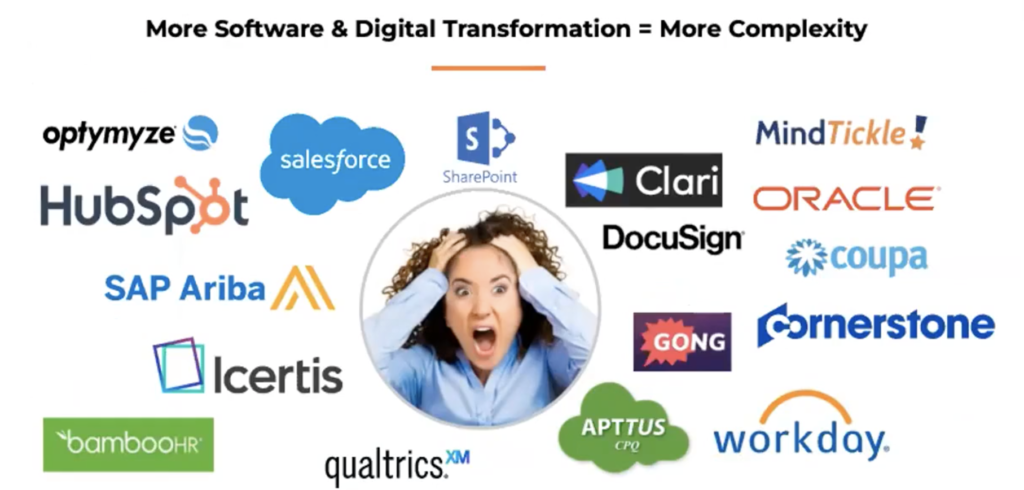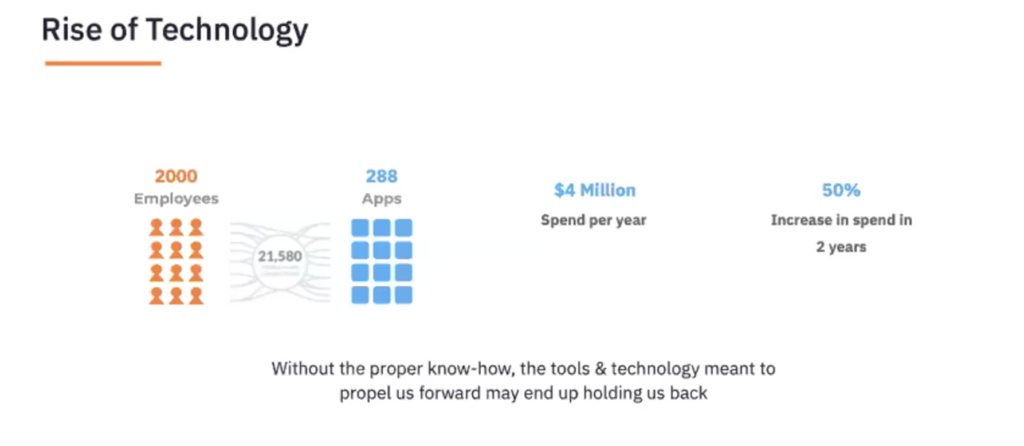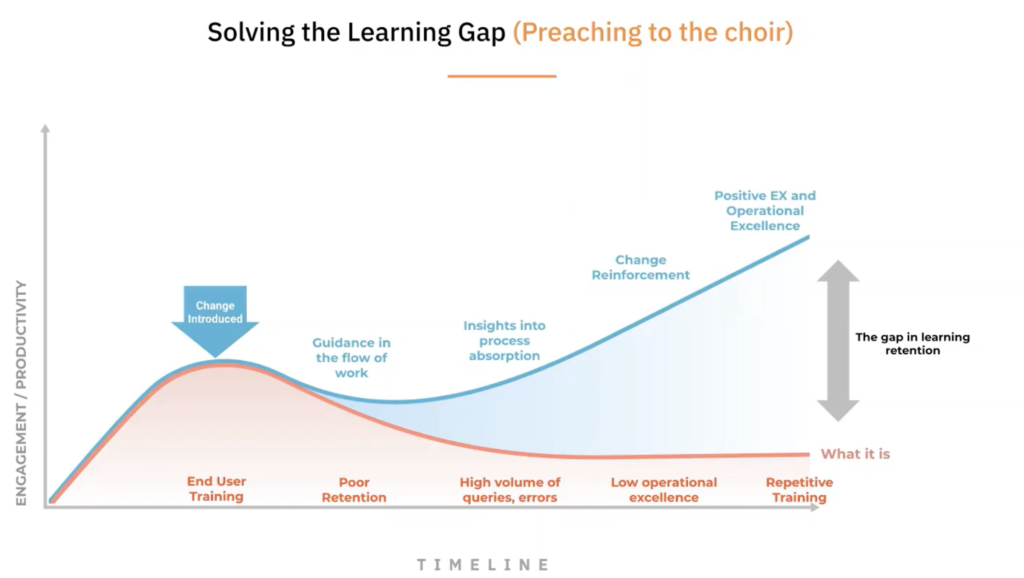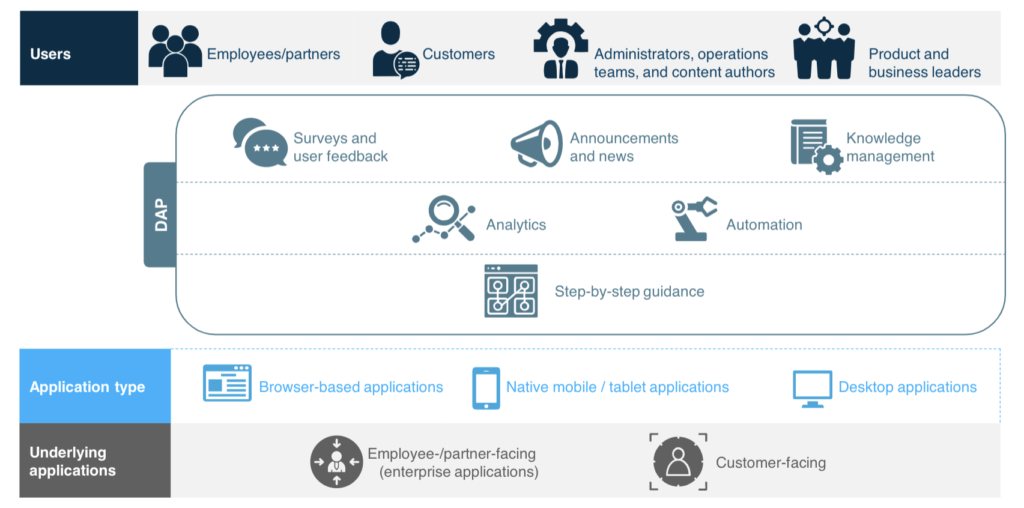Many big corporations throughout the world have already proclaimed a remote-first policy, if not a permanent strategy. As a result of all of this, we’ve arrived at a hybrid labour situation. So, what are some of the difficulties that learning and development professionals encounter when offering training to a hybrid workforce? Then, from the standpoint of digital adoption, how can businesses reimagine employee training so that they can provide better experiences to their customers, and to their users, and how can they learn while working? How can we ensure that your personnel is upskilled while they are working without affecting their productivity?
Gartner published a report titled Enterprise Spending in 2021. The total expenditure for 2021 was just over $500 billion. Gartner published research in October forecasting enterprise spending on it through 2022. That’s $660 billion, correct? A typical organization employs 900 applications on a daily basis. At the moment, I believe there are roughly 300 cloud applications. That is, however, a significant amount. As a result, businesses are suffocating under the weight of software. As a result, the digital transition has been extremely beneficial. It’s altered the way we go about our business.

As a result, digital transformation has been fantastic. It has transformed the way we do things and has increased efficiency. However, there has been an increase in the number of applications. But considering the difficulty you face these days, there is an application that may solve it for you. The majority of software written by software programs isn’t always better. Isn’t it true that more software equals more complexity? If you look at a normal salesman at a typical company, they’re utilizing a CRM, a CPQ tool, and an enablement tool.
That’s fantastic because the number of applications you have to utilize on a regular basis grows. You’ll need more applications to get a contract signed, read, and exchange information with your coworkers. So, when you combine all of our corporate systems across organizations, such as HubSpot and HR applications, it becomes unpleasant, right? So I’d like to finish my work. However, I do not want to be forced to deal with so many applications on a daily basis. As a result, more software might sometimes entail more complexity.

Now, over the last year, the average spend per organization has been $4 million, and over the last two years, especially with the pandemic forcing all of your files to remote work situations, this pen has climbed by 50%. As a result, the number of software applications has increased rapidly. But, on the other side, it’s fantastic that we have all of this technology in place, as well as software apps that may assist us in solving various difficulties. However, without the required know-how, particularly for your staff, if they do not have the appropriate training, they will not receive the appropriate reinforcement. If they can’t make excellent use of these programs at their disposal, then there’s a problem.
So, as we discussed earlier, digital transformation is to be expected, and technology is to be expected. To make things less difficult. Make things easier for us by automating processes, reducing errors, improving data accuracy, and increasing compliance. All of this has aided us in completing tasks in less time and with fewer employees, but there has also been an impact. McKinsey published some intriguing research. 90% of CEOs, executives, and businesses are suffering from talent gaps right now. Technology has advanced at a rate that humans have not been able to keep up with. However, when it comes to technology, 90 percent of executives are currently struggling with talent deficits. With the increase in technology change management has also been a significant concern.
As a result of remote work, the time it takes to find information has grown. Learners can get disengaged, as we’ve seen before. These are some of the drawbacks of standard training methods in a remote or mixed work environment. And, if you take a step back, you’ll notice that there’s been a movement from passive to on-demand consumption. Humans, we believe, are needed to properly understand applications. But I believe it is past time for applications to better comprehend humans; I believe we can do a better job of understanding how humans need to get things done through our applications.
Learning must be integrated into their working environment. The information must be bite-sized and easy to digest, and it must be available at the point of need when completing a task. As a result, information must be accessible from across your corporate systems, wherever the user or learner is, and it must be available at the time of the AMA. It’s a big claim to say that you can personalize information for each and every person. As a result, it is imperative that context be established.

Their work atmosphere must be conducive to learning. Information should be bite-sized and easy to ingest, and it should be available when needed. As a result, information must be available throughout your enterprise systems, wherever the user or learner is, and at the time of the AMA. When I say customized, I’m referring to the fact that it must be customized. It’s a big claim to say you can personalize information for each and every person. As a result, it is imperative that context be provided.
There are numerous types of users. An experience layer that sits between your application and your user is what a digital production platform is. Now, all of your programs, or at least most of them, use that the experience is wonderful, the UI is really, very good, and they’re really intuitive. However, there are still some business-necessary applications where the user experience isn’t as frictionless as we’d like. So. And when we talk about expanding the experience across these apps and the enterprise, we’re not talking about one app or two apps; we’re talking about delivering a consistent experience to customers across various apps within Enterprise.
What can you do with the digital adoption platform? You may provide step-by-step instructions for essential workflows to your users. There will be small bubble suggestions that display to assist your users in becoming comfortable with essential workflows on a certain application, as well as the ability to automate certain tasks to save time and increase productivity. You can make all of your help content, support content rate, and knowledge that’s available across your enterprise accessible for your users, within whichever application they’re currently using.

You may accomplish this with many types of notifications, such as pop-up notifications, smart tips, and so on. In addition, there are some strong metrics within a DAP that will help you understand how your users engage with your applications. So, where do they spend the majority of their time? Where are they receiving assistance while they struggle to make progress? Then use those insights to fill in the gaps, generate assistance content, and develop experiences that simplify the user experience on your applications and assist them in making better use of them.
So, whether it’s a development platform or a production platform, you can provide users with a seamless onboarding experience, as well as in-app guidance and contextual training. It also aids in seamless change management, allowing you to highlight changes made to applications and rapidly familiarise users with those workflows. So you can accomplish it all with a DAP, which provides continuous learning for your customers and helps you optimize the learning experience while working in the app. As a result, the digital adoption platform can play an important function in knowledge retention.
Dharshan is a product marketer who has assisted in bringing early-stage enterprise SaaS technologies to market across several sectors. His current focus is on how HR and learning technology is enabling businesses to digitise their workspaces and promote employee development and engagement.
Copyright © 2024 Whatfix. All rights reserved
This website is owned and operated by Whatfix Private Limited (Formerly known as Quicko Technosoft Labs Private Limited)